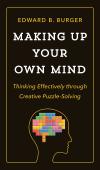
 Making up Your Own Mind: Thinking Effectively Through Creative Puzzle-Solving
by
Burger, E. B.
Making up Your Own Mind: Thinking Effectively Through Creative Puzzle-Solving
by
Burger, E. B.
|
St. Louis Community College Libraries |
Florissant Valley Campus Library |
Forest Park Campus Library |
Meramec Campus Library |
Wildwood Campus Library |
|
|